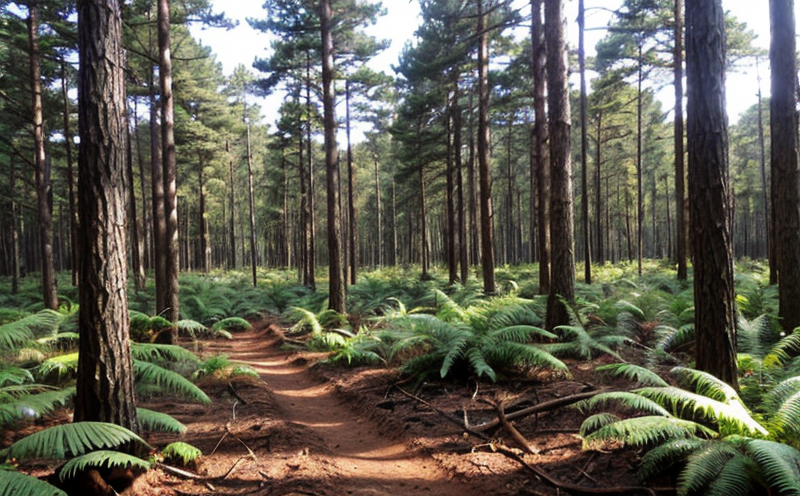Soil Infiltration Rate Measurement
In the realm of agriculture and forestry testing, soil infiltration rate measurement plays a critical role in ensuring sustainable land management practices. The infiltration rate is defined as the volume of water that can percolate into the soil over time under given conditions. This parameter is essential for understanding how effectively rainwater or irrigation water penetrates the soil, which impacts plant growth and overall ecosystem health.
Accurate measurement of soil infiltration rates helps in optimizing water use efficiency, reducing runoff, and preventing erosion. In agricultural contexts, this translates to better crop yields and more efficient resource management. For forestry applications, it ensures that planted areas are suitable for tree growth and can support the necessary moisture retention required by various species.
The measurement of soil infiltration rates is especially important in environments where water availability is a critical factor. This includes arid regions where every drop counts or in heavily forested areas where runoff could lead to significant environmental damage if not managed properly. By conducting these measurements, stakeholders can make informed decisions regarding irrigation schedules, fertilization practices, and even site selection for agricultural or reforestation projects.
Understanding the soil infiltration rate also aids in assessing the health of existing ecosystems. Changes in this parameter over time could indicate issues such as compaction due to heavy machinery use, excessive waterlogging leading to root diseases, or alterations caused by climate change factors like increased temperature and precipitation patterns.
In summary, measuring soil infiltration rates provides valuable insights into the capacity of soils to absorb moisture efficiently, thereby supporting both agricultural productivity goals and environmental sustainability objectives within forestry sectors. It is an indispensable tool for quality managers, compliance officers, R&D engineers, and procurement teams looking to ensure optimal performance across these industries.
Why It Matters
The measurement of soil infiltration rate is crucial because it directly influences the success of agricultural and forestry operations. For instance, in agriculture, knowing the exact amount of water that can penetrate into the soil helps farmers design efficient irrigation systems that minimize waste while maximizing plant hydration.
- Optimized Water Use: By accurately measuring how much water infiltrates the soil, farmers can adjust their irrigation practices to match these rates. This leads to reduced water consumption and lower operational costs.
- Avoiding Runoff: Knowing the infiltration capacity allows for better management of rainfall or irrigation events, ensuring that excess water does not wash away topsoil rich in nutrients.
- Improved Crop Yield: Efficient soil moisture retention enhances root development and overall plant health, leading to higher crop yields.
- Sustainable Forestry Practices: In forestry, understanding the infiltration rate helps select suitable sites for planting new trees and manage existing forests more sustainably. It ensures that newly planted areas have adequate water availability without causing overwatering elsewhere.
Additionally, this information is vital for regulatory compliance purposes, helping organizations meet environmental standards set by various bodies worldwide. Accurate data on soil infiltration rates supports better decision-making processes related to land use planning and resource allocation within both sectors.
Scope and Methodology
The scope of the Soil Infiltration Rate Measurement service includes a comprehensive approach that covers all aspects from initial site assessment through final reporting. The methodology employed adheres to recognized international standards such as ISO 18567, which provides guidelines for soil water characteristics.
Before initiating any measurements, our team conducts an on-site evaluation to determine the suitability of the area based on factors like soil type, topography, and surrounding vegetation. This assessment ensures that the chosen site accurately represents the broader landscape being studied.
The actual measurement process involves creating small plots in the field where water is applied at controlled rates using standardized equipment. The amount of water absorbed into the soil over a set period provides an indication of its infiltration capacity. We use advanced sensors and data loggers to record these values precisely, ensuring high accuracy throughout the procedure.
Once all necessary readings have been collected, our expert analysts compile this information into detailed reports that include graphs and charts illustrating trends in soil moisture retention over time. These reports serve as valuable tools for stakeholders seeking to understand current conditions and plan future interventions effectively.
We also provide recommendations tailored specifically to each client based on their unique needs and goals within either agricultural or forestry contexts. Whether it's improving irrigation strategies, enhancing forest health, or complying with local regulations, we offer actionable insights derived directly from our measurements.
Why Choose This Test
- Precision: Our tests are conducted using state-of-the-art equipment and techniques that ensure highly accurate results.
- Compliance: By adhering to established international standards, we help clients meet regulatory requirements related to soil management practices.
- Expertise: With years of experience in agricultural and forestry testing, our team brings specialized knowledge to every project undertaken.
- Sustainability Focus: We emphasize long-term sustainability by providing recommendations that promote environmentally friendly land use strategies.
- Custom Solutions: Every client receives customized solutions designed specifically for their particular circumstances and objectives.
- Reputation: Trusted by numerous organizations across various sectors, we have established a reputation for delivering reliable services consistently.
- Supportive Data Analysis: In addition to raw data collection, we offer detailed analysis reports that interpret findings in meaningful ways relevant to decision-making processes.
Selecting the Soil Infiltration Rate Measurement service means investing in robust and actionable intelligence about your land resources. This investment will pay dividends through improved productivity, reduced costs associated with unnecessary water usage or environmental damage, enhanced compliance standing, and ultimately, greater overall success within your agricultural or forestry endeavors.





